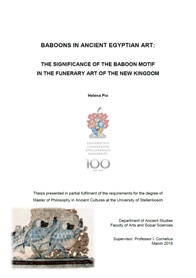
Твърде любопитна дисертация от университета Стеленбош (Южна Африка), която анализира присъствието на мотиви с павиани в изкуството на Новото царство (XVIII-XX династии, ок. 1550-1069 г. пр. н.е.) на Древен Египет и тяхното символично значение в религиозните вярвания.
Макар да не са ендемично разпространен вид в долината на Нил, павианите се внасят в страната от дълбока древност. Особено интензивен е притокът на тези животни именно през този период, когато Египет е световна сила и изпраща редовни военни експедиции в Куш (Нубия, Судан) и Пунт (Сомалия).
Сред всички останали екзотични животни павианите се радват на особен интерес и респект от страна на египтяните. Интелектът, природната любознателност, бързината и ловкостта, както и страховитите кучешки зъби са причина да се радват се на изключително уважение.
От друга страна един от инстинктивните им колективни навици - да посрещат изгряващото слънце издавайки хорово специфични щракащи звуци ги превръща вече в обект на религиозен култ. Египтяните смятат,че по този начин те почитат Ра (Ре) - бога на слънцето. Показната им сексуалност пък ги прави обичан образ за изразяване на креативните сили в природата.
Този богат набор от впечатления и асоциации намира израз в изкуството на погребалната живопис, където те присъстват често и се намират в центъра на сложна символика.
Helena Pio - Baboons in Ancient Egyptian art : the significance of the baboon motif in the funerary art of the New Kingdom, Stellenbosch, Stellenbosch University, 2018
- на английски език, от Stellenbosch University, формат PDF.Свалянето става с десен бутон (downloading by right button) и Save as...
| 
